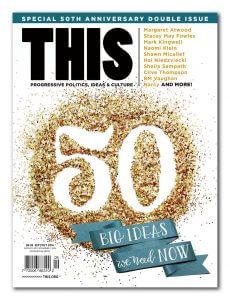Activists think like artists
Reflections from an environmentalist at the AGO
Gideon Forman
 For our special 50th anniversary issue, Canada’s brightest, boldest, and most rebellious thinkers, doers, and creators share their best big ideas. Through ideas macro and micro, radical and everyday, we present 50 essays, think pieces, and calls to action. Picture: plans for sustainable food systems, radical legislation, revolutionary health care, a greener planet, Indigenous self-government, vibrant cities, safe spaces, peaceful collaboration, and more—we encouraged our writers to dream big, to hope, and to courageously share their ideas and wish lists for our collective better future. Here’s to another 50 years!
For our special 50th anniversary issue, Canada’s brightest, boldest, and most rebellious thinkers, doers, and creators share their best big ideas. Through ideas macro and micro, radical and everyday, we present 50 essays, think pieces, and calls to action. Picture: plans for sustainable food systems, radical legislation, revolutionary health care, a greener planet, Indigenous self-government, vibrant cities, safe spaces, peaceful collaboration, and more—we encouraged our writers to dream big, to hope, and to courageously share their ideas and wish lists for our collective better future. Here’s to another 50 years!
In January, I visited the Art Gallery of Ontario to view 19th-century landscape painter J.M.W. Turner’s work. Notepad in hand, I jotted key phrases from the explanatory panels. One read: “Turner experimented relentlessly.” I thought: What about me? In my role as environmentalist, am I an experimenter?
Over the past decade I’ve developed a repertoire of activist tactics—polling, meeting with government, advertising—that has served me well. I’ve contributed to successful campaigns including those to ban pesticides and close coal-fired power plants. I’ve created slightly uncommon partnerships with business and anti-poverty groups. But I wouldn’t say my activism has novelty as a key feature. It sometimes accomplishes its goal but it mostly employs old tools.
By contrast, look how the AGO characterizes Turner: he “constantly varied his tactics;” “experimented endlessly;” “tested unorthodox combinations;” engaged in “ceaseless trials.” Even the descriptions are thrilling. They suggest a man obsessed with variety, renewal, the taking of risk. The exhibition features clips from a film showing the artist at work. In one scene he abandons the brush and spreads paint with his thumb. In another we see him spitting at the canvas. Perhaps he intended to spit at the art-world’s received wisdom.
His sketches and colour studies numbered in the thousands. I thought: How can I develop a comparable willingness to try different avenues? To spit at old methods and investigate new ones? To be an environmentalist who’s also a restless artist?
In my advocacy work, I’ve done the standard stuff: lobbying and publishing commentaries. But both I and others need to take on Turner’s courage—his openness to promising projects which end up quite wrong, a mess. His tolerance of failure. Of course, enviros sometimes take risks. Consider the “100 percent Possible” campaign that surfaced in the run-up to the 2015 Paris climate negotiations. It organized a massive Ottawa rally that cleverly married a social-justice message about job-creation to an affirmation that renewable energy can supply all our power. There’s also Environmental Defence’s “Just Beautiful,” which builds support for banning toxic chemicals by showing their presence in everyday products such as tooth paste.
We need more of these new approaches. The old ones won’t be effective forever and, besides, newness can delight the mind, electrify our work, and attract people to our cause.
Confession: I didn’t find Turner’s paintings especially moving. While I knew they were great, I didn’t connect emotionally. What drew me was their process of making. I found exhilarating the artist’s commitment to trial and error—error especially— which he pursued without pause. Would that we activists took as many chances.
Gideon Forman is a long-time environmentalist.